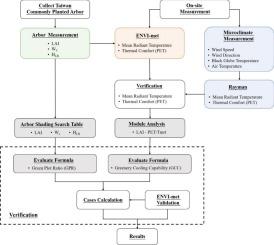树木遮荫程度对人体热舒适的影响及应用评价工具的开发
IF 9.2
1区 环境科学与生态学
Q1 ECOLOGY
引用次数: 0
摘要
随着全球变暖和城市热岛效应的加剧,植被在城市空间遮阳降温中发挥着至关重要的作用。大量种植树木不仅有助于城市降温,而且通过提供遮荫来提高人体的热舒适性。实施政府政策法规是促进城市绿化的有效策略。然而,台湾目前缺乏全面的树木遮阳能力评估数据库和评估方法,难以客观评估城市绿化覆盖程度。本研究以台湾地区38种常见树种为研究对象,利用ENVI-met模拟了叶面积指数(LAI)的6种情景。以遮阳能力为基础,建立树木遮阳能力指数,分析不同LAI值对人体热舒适的影响。此外,还开发了两个评估公式——绿色容积率(GPR)和绿化降温能力(GCC)——来评估给定地点的绿化数量及其降温效果。结果表明,高lai树木在城市环境中具有显著的遮阳和降温作用。随着LAI的增加,ΔTmrt和ΔPET的减少变得更加明显。植被覆盖度与降温效果之间存在很强的相关性。其中,当GPR达到2.2时,一个站点的平均PET降低1.8℃,当GPR增加到3.2时,PET降低4.4℃。本研究提出的探地雷达已纳入台湾的绿化覆盖率法规。本文章由计算机程序翻译,如有差异,请以英文原文为准。

The influence of trees shade level on human thermal comfort and the development of applied assessment tools
With the intensification of global warming and the urban heat island effect, vegetation plays a crucial role in shading and cooling urban spaces. The extensive planting of trees not only contributes to urban cooling but also enhances human thermal comfort by providing shade. Implementing government policies and regulations is an effective strategy for promoting urban greenery. However, Taiwan currently lacks a comprehensive database and assessment methodology for evaluating tree shading capacity, making it challenging to objectively assess the extent of urban green coverage.
This study conducted empirical measurements on 38 common tree species in Taiwan and utilized ENVI-met simulations to model six scenarios of the Leaf Area Index (LAI). Based on shading capacity, a tree shading capacity index was established, and the impact of varying LAI values on human thermal comfort was analyzed. Additionally, two evaluation formulas—Green Plot Ratio (GPR) and Greenery Cooling Capability (GCC)—were developed to assess the amount of greenery at a given site and its cooling effectiveness.
The results indicate that high-LAI trees provide significant shading and cooling benefits in urban environments. As LAI increases, the reductions in ΔTmrt and ΔPET become more pronounced. A strong correlation was observed between greenery coverage and cooling effectiveness. Specifically, when GPR reaches 2.2, the average PET of a site decreases by 1.8 °C, and when GPR increases to 3.2, PET decreases by 4.4 °C. The GPR proposed in this study has already been incorporated into Taiwan’s green coverage regulations.
求助全文
通过发布文献求助,成功后即可免费获取论文全文。
去求助
来源期刊

Landscape and Urban Planning
环境科学-生态学
CiteScore
15.20
自引率
6.60%
发文量
232
审稿时长
6 months
期刊介绍:
Landscape and Urban Planning is an international journal that aims to enhance our understanding of landscapes and promote sustainable solutions for landscape change. The journal focuses on landscapes as complex social-ecological systems that encompass various spatial and temporal dimensions. These landscapes possess aesthetic, natural, and cultural qualities that are valued by individuals in different ways, leading to actions that alter the landscape. With increasing urbanization and the need for ecological and cultural sensitivity at various scales, a multidisciplinary approach is necessary to comprehend and align social and ecological values for landscape sustainability. The journal believes that combining landscape science with planning and design can yield positive outcomes for both people and nature.
 求助内容:
求助内容: 应助结果提醒方式:
应助结果提醒方式:


